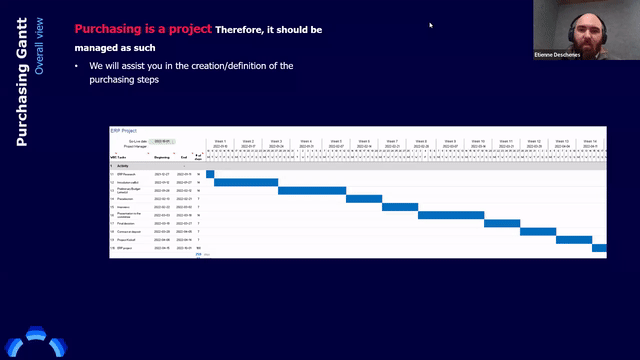
Purchasing an ERP system is a project — and needs to be managed like one to ensure a successful rollout. Establishing an organized and structured approach, along with a defined timeline, is crucial to completing your project and successfully implementing an ERP system.
How to Structure an ERP Procurement Project
The best way to start your ERP procurement project is to create a spreadsheet to serve as a roadmap. Use your spreadsheet to meticulously plan out the necessary steps you need to take — including specific dates — to achieve your ultimate goal of a successful ERP implementation. Start by determining the desired Go Live date that you want, and then work backward, outlining the series of steps and tasks that you need to accomplish to meet that target.

Up to 75% of ERP implementations are considered failures, with improper ERP selection being one of the main contributors: If you choose the wrong software at the outset, your implementation is more likely to fail. Putting in the legwork upfront will help you find the best system for you, increasing your chances of success and minimizing the risks associated with selecting the wrong ERP software for your business.
10 Steps to Picking and Implementing the Right ERP
Establishing a timeline for your ERP project will not only keep your project running on time and help your team to better plan and manage their own time, but it will also help you to evaluate potential vendors to see if they can meet your needs.
A word of caution before you start your project: Make sure that you have tackled the big issues that you have and that you have well-defined answers to questions like what are the main pain points you are trying to address. In this way, you will know what type of system you are looking for, what features you need and what processes you want to improve — and you won’t be led astray by shiny sales pitches or demos. The more you have defined for yourself and the more concrete answers you can share with potential ERP vendors, the more successful your project will be.
Not sure where to start? Read on to find out the ten steps to take — along with the timeframe for each — that have been established by our ERP experts.

Step 1 – ERP Research
Timeframe: Approximately 2 weeks
Choose one person, or a very small group, to be responsible for researching and finding the ERP companies you want to consider.
- Identify 5-10 potential vendor companies, adjusting the number based on your specific requirements. For instance, the number of companies you investigate may be lower if you need a particular feature like a CAD-to-BOM connection.
- Prioritize vendors within your industry, such as those specializing in custom manufacturing. Focusing on selection criteria relevant to your industry increases the likelihood of finding companies that can better cater to your needs.
- Exercise caution when using search engines like Google, as they can introduce a bias towards sponsored content. When researching ERPs, the top search results often belong to large companies that pay the most for advertisements. Instead, consider visiting websites like Capterra and Software Advice, which specialize in software reviews based on user feedback and provide comprehensive pros and cons analysis.
Step 2 – Introduction Calls
Timeframe: Approximately 2 weeks
Now is the time to call the companies on your shortlist. The purpose of these calls is to ensure that each vendor understands your goals and to see which solutions could be a good fit for you and are geared toward your needs. You will probably disqualify some vendors at this point — which is a good thing; you don’t want to waste time on solutions that aren’t right for you.
- Ensure that each vendor understands what you are trying to achieve and the motivation behind the project. Clearly articulate 2-3 pain points that are hurting your business the most and what improvements you are looking for.
- Provide vendors with comprehensive information about your needs, budget, decision-making process, and deadline. This includes sharing key details that will help them understand your requirements and will help you both to evaluate their compatibility with your business.
- Evaluate whether the proposed solutions align effectively with your needs. Avoid investing unnecessary time and effort by determining early on if a system fits your requirements.
- Ensure to take thorough notes during the calls. This will help you identify which companies are the most promising matches for your business.
Step 3 – Preliminary Budget Letters
Timeframe: Approximately 2 weeks
Request that each company you are considering provide you with an estimated cost for their system to help you determine which options align with your budget and which ones are significantly beyond your means.
- Identify your top 3-4 pain points and request a budget letter based on the information you shared on the introductory call.
- Ensure that you provide sufficient details to establish a high-level budget for the project.
- Ask detailed questions about the less expensive solutions to verify if they can genuinely meet your requirements or if they lack certain essential features that you are looking for.
- Although you are not seeking a final price at this stage, aim for a ballpark figure to get a sense of the actual cost of each system.
Step 4 – Preselection
Timeframe: 1 week
It’s time to narrow down the list of potential ERP partners to 2-3, as well as to establish an internal ERP selection committee. Both the partners you choose to go forward with, as well as your internal team are important and will have a big impact on your final decision, so be mindful of your selections.
- Narrow down the number of potential partners on your list to 2-3, picking solutions most suited to your needs.
- Pick members to be on your selection committee by considering their soft skills as well as their position in the company.
- Be aware that ERP means compromise and that not everyone will get everything that they want.
Step 5 – Interviews
Timeframe: Ideally 1 week
Try to hold all vendor interviews within 1 week to keep everything fresh in your head. This is an opportunity for each potential vendor to do one-on-one interviews with all of the key players in your organization. While this is a time-consuming step, it will really help you to find the best solution that fits all of your needs.
- A successful ERP project goes beyond finding the right ERP system. True success only comes when users are motivated to use the system properly. Giving your team a chance to sit down early on with vendors to gain understanding will help to make your project a success.
- Plan 30 minutes for all your key players to explain where they are in terms of their ERP knowledge, plus to explain their needs and their interactions with other members of your organization.
- An ERP is an opportunity to establish connectivity within your organization. Having someone opposed to the project will affect the quality of the interviews and the overall project’s success. Make sure that your team receives proper coaching and is adequately prepared for the upcoming changes.
Step 6 – Demo / Presentation to the Committee
Timeframe: Ideally 1 week
This is your first real chance to see each software solution in action. Try to do all the demos within one week if you can, as keeping them tightly together helps you to better remember and evaluate all of the solutions. Also, remember to book 30 minutes after each demo to take time to talk about the software with your selection committee.
- You will need your whole decision-making team to attend the demo/presentation.
- This step is somewhat counter-intuitive, as manufacturers often want to see a quick ERP software demo during the introductory call. The risk of doing a demo early is that you may get a great demo from the worst solution or a bad demo from the best vendor because they didn’t understand your real pain points. You want each demo to be customized to what you truly need to get out of the software, so it’s better to wait to do the demos later in the ERP selection process.
Step 7 – Final Decision
Timeframe: Approximately 1 week
You may need to do a couple of in-depth presentations with some of your key players to get all the information you need: For example, you might need to do a technical call with a drafting technician to ensure the software has the exact technical specifics/functionalities you need. Try to be succinct to keep your momentum going.
- Ask yourself, do you have everything you need? Do you have enough information to make a final decision?
- Be cautious, as the more software you evaluate, the greater the potential for back-and-forth communication and decision-making.
- Engaging with numerous companies for demos can actually obscure your vision rather than provide clarity.
Step 8 – Contract and deposit
Timeframe: 1 week
Congratulations! You have made a final decision and picked the right ERP solution for your needs. Now it is time to get a final contract and price. Ensure you review and finetune the contract. You will also need to submit a deposit with the signed contract, so if you need financing or grants to purchase the system, be sure you have prepared this ahead of time.
- Take the time you need to review any specific details of the contract before you sign it.
- It’s time to put your money where your mouth is, so to speak.
Step 9 – Project Kick-off
Timeframe: Approximately 1 week
This step usually takes place one week after the deposit has been received. During this stage, you will work with your vendor to set the parameters for implementation and training. Are you hosting your new ERP system on-site? If so, your server needs to be ready.
- Your project team will be assigned to you.
- The project kick-off call will involve a comprehensive discussion and agreement on the entire project delivery flow.
- Decisions regarding the training format (phased vs. big bang approach) will be made.
- Software installation and access procedures will be established.
Step 10 – Implementation
Timeframe: Approximately 24 weeks (3-6 months)
Implementation methodologies vary from company to company, but at Genius ERP, we like to plan a shorter timeline of three to six months to keep your momentum going and ensure you get your new system up and running quickly.
RELATED ARTICLE: The Fail-Proof Genius ERP Implementation Process
Our methodology divides the implementation project into three phases:

Conclusion
Selecting and implementing a new ERP is a huge undertaking, but with proper planning and project management, you can navigate the complexities and ensure a successful and smooth transition to your new system. Using your roadmap and following these ten steps will guide you through the entire process, providing a structured approach and increasing the likelihood of achieving your desired outcome of getting the right ERP system for your manufacturing business.
Get your eBook Scared to implement a new ERP?
"*" indicates required fields



